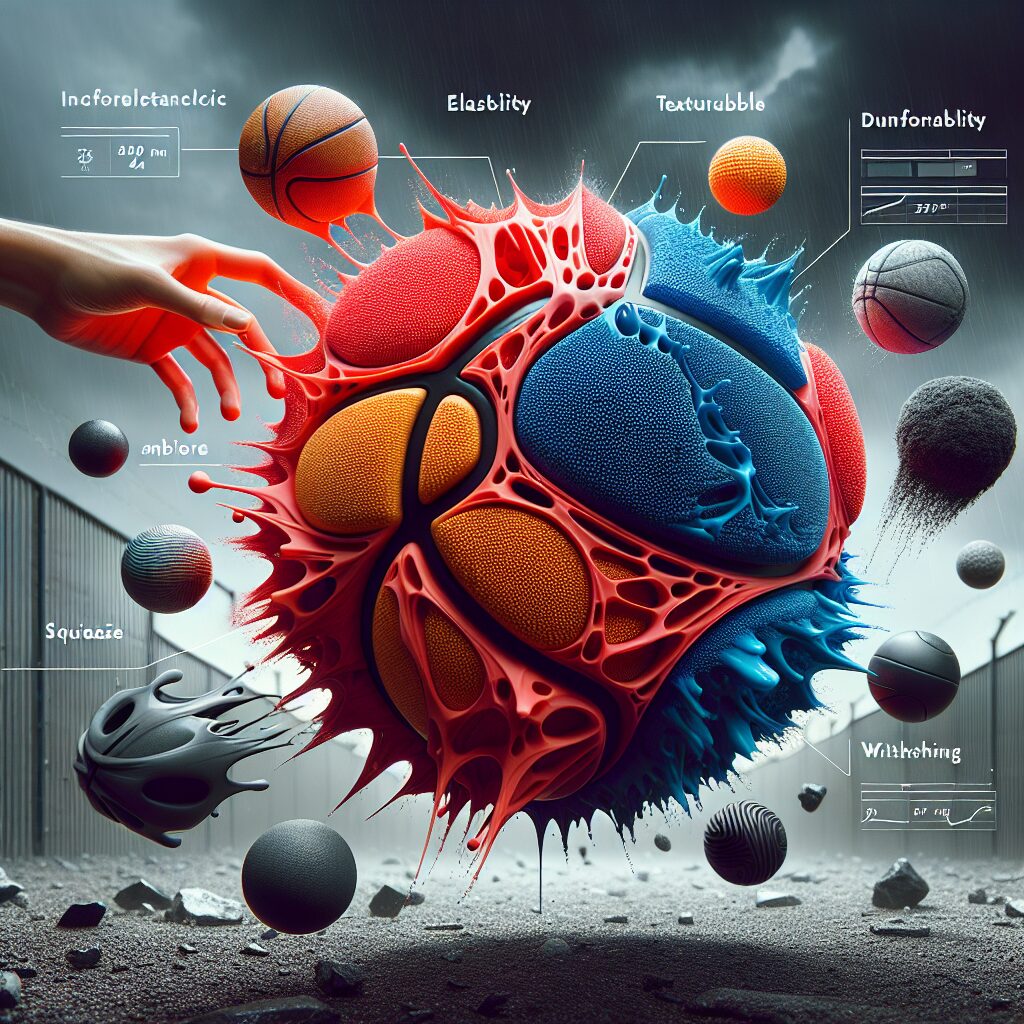Rubber Properties: Key to Ball Performance
Rubber is a versatile material known for its unique properties, making it a crucial component in the manufacturing of various products. In the world of sports, particularly in ball sports, the properties of rubber play a significant role in determining the performance of the ball. One fascinating fact about rubber is its ability to absorb and disperse energy efficiently, providing the necessary bounce and control required in ball games. This feature, along with several other key rubber properties, directly impacts the way balls behave on different surfaces and influences crucial aspects of the game.
Rubber’s elasticity is one of its prime properties that greatly affects ball performance. The elastic nature of rubber allows it to deform upon impact and quickly regain its original shape, resulting in a powerful rebound. This property is particularly essential in sports such as basketball and tennis, where the ball needs to bounce effectively off the surface. Additionally, rubber’s ability to grip the playing surface is of utmost significance in sports such as soccer and golf, where control and accuracy are vital.
Moving forward, let’s delve into the key takeaways that highlight the crucial rubber properties influencing ball performance. We will explore how the hardness and compression of rubber impact bounce, the impact of surface temperature on rubber, and the role of rubber friction in ball control. By understanding these key factors, we can gain a deeper appreciation for the intricate relationship between rubber properties and ball performance, ultimately enhancing our enjoyment and understanding of various sports.
Key Takeaways
1. Rubber properties play a crucial role in determining the performance of balls used in various sports, including tennis, golf, and soccer.
2. The hardness, elasticity, and resilience of the rubber used in ball manufacturing significantly affect its bounce, spin, and flight characteristics.
3. Different sports require specific rubber properties to optimize performance, such as softer rubbers for better grip in tennis or harder rubbers for longer distances in golf.
4. Manufacturers continuously strive to improve rubber formulations by experimenting with various materials, additives, and manufacturing processes to enhance ball performance.
5. Understanding the key rubber properties for each sport and ensuring consistent manufacturing standards are essential to provide players with the best possible ball performance.
Material Composition and Durability
One of the key rubber properties that significantly affects ball performance is the material composition of the rubber. Different types of rubbers, such as natural rubber or synthetic rubber, exhibit varying levels of durability, elasticity, and grip. The choice of rubber material impacts the bounce, spin, and overall performance of the ball.
Elasticity and Rebound
Elasticity is another crucial rubber property that contributes to ball performance. The ability of the rubber to stretch and quickly regain its form after deformation affects the speed and power of the bounce. Higher elasticity allows the ball to rebound more efficiently, making it suitable for sports like tennis or basketball where a fast and energetic bounce is desired.
Traction and Grip
The traction and grip provided by the rubber surface play a critical role in ball performance, especially for sports involving throwing or striking motions. The level of friction between the rubber and the playing surface determines the control, accuracy, and spin that can be imparted on the ball. A high coefficient of friction enhances grip, allowing players to achieve better control and maneuverability.
Resistance to Wear and Tear
In sports like soccer or volleyball, where the ball undergoes frequent impact and friction with different surfaces, the rubber’s resistance to wear and tear is of utmost importance. Rubber with excellent durability and resistance to abrasion ensures that the ball maintains its performance characteristics over an extended period, despite continuous use.
Surface Texture
The surface texture of the rubber can significantly influence ball performance. Different patterns, designs, or dimples on the rubber surface can alter the aerodynamics, flight stability, and spin of the ball. For example, golf balls with specific dimples are designed to reduce drag and enhance lift, allowing for maximum distance and accuracy in flight.
Temperature Sensitivity
Some rubber materials are sensitive to temperature changes, which can affect the ball’s performance. Cold weather can cause the rubber to harden, resulting in reduced elasticity and a decrease in bounce height. On the other hand, excessive heat can make the rubber softer, altering its responsiveness and potentially affecting control.
Moisture Absorption
Moisture absorption is a critical rubber property for balls used in water sports like water polo or beach volleyball. The ability of the rubber to repel or absorb water affects the ball’s weight, grip, and overall performance. Specifically-designed rubber formulas are often used to ensure optimal water resistance and prevent waterlogging.
Noise and Impact Damping
Rubber characteristics can impact the level of noise produced during ball impacts, especially in sports like table tennis or squash. Rubber with excellent impact damping properties reduces vibration and noise, allowing for a more comfortable and controlled playing experience. This property is particularly important for players who value precision and minimal distraction.
1. How to Choose the Right Rubber for Your Preferred Sport?
To optimize ball performance, it is crucial to select the appropriate rubber considering the specific requirements of your sport. Factors such as surface type, desired bounce, grip, and durability should be taken into consideration. Research and consult with experts or experienced players to identify the ideal rubber properties for your specific sporting needs.
2. Proper Maintenance and Cleaning for Prolonged Rubber Performance
To extend the longevity and sustain optimal performance, it is essential to maintain and clean the rubber regularly. Use appropriate cleaning solutions and techniques recommended by manufacturers to remove dirt, debris, or sweat buildup. Additionally, store the ball in a proper container or bag to prevent unnecessary exposure to external elements that might degrade the rubber properties.
3. Understand the Impact of Rubber Properties on Game Strategy
Recognizing the influence of rubber properties on ball performance allows you to strategize your game effectively. Understanding how different rubbers impact bounce, spin, or grip can provide insights into exploiting certain strategies or adjusting playing techniques accordingly. Stay informed about the latest advancements and developments in rubber technology to optimize your gameplay.
Frequently Asked Questions
1. What are rubber properties?
Rubber properties refer to the characteristics of rubber that determine its behavior and performance in various applications. These properties include elasticity, resilience, hardness, durability, and resistance to abrasion and chemicals.
2. How do rubber properties affect ball performance?
Rubber properties play a crucial role in determining the performance of balls in sports. The elasticity and resilience of rubber impact the ball’s bounce, while the hardness affects its ability to maintain shape and withstand impact. Rubber properties also influence grip, spin, and overall durability of the ball.
3. Which rubber properties are important for a tennis ball?
For a tennis ball, properties such as bounce, durability, and resistance to wear are key. The rubber needs to have sufficient elasticity to provide a consistent bounce, while being durable enough to withstand intense game play without wearing out quickly.
4. Do rubber properties differ between different types of balls?
Yes, the rubber properties can vary depending on the type of ball and its intended use. For example, the rubber used in a soccer ball would have different properties compared to a golf ball or a basketball. Each type of ball requires specific rubber properties to optimize its performance.
5. Can rubber properties affect the feel of a ball?
Absolutely! Rubber properties can significantly impact the feel of a ball. The softness or hardness of the rubber can determine the level of cushioning and impact absorption, thus influencing how the ball feels when struck or held.
6. How do manufacturers determine the rubber properties for a specific ball?
Manufacturers consider various factors, such as the intended use of the ball, the desired performance characteristics, and customer preferences. They conduct extensive research and testing to select the appropriate rubber composition and optimize its properties accordingly.
7. Can rubber properties affect the flight of a ball?
Yes, rubber properties can impact the flight of a ball. For example, in the case of golf balls, the spin imparted by the rubber cover can affect its trajectory. Similarly, in sports like baseball or cricket, the rubber hardness can influence the bounce and movement of the ball after impact.
8. How can rubber properties be improved or modified?
Rubber properties can be enhanced or modified through various techniques. The addition of specific additives or fillers can alter the properties to meet specific requirements. Additionally, the process of vulcanization can change the rubber’s structure and improve its properties.
9. Are there any standards or regulations for rubber properties in balls?
Yes, there are standards and regulations in place for rubber properties in balls, particularly for sports that involve competitive play. Organizations such as the International Tennis Federation (ITF) or the International Basketball Federation (FIBA) set guidelines to ensure fair play and consistent performance standards.
10. Can the rubber properties of a ball deteriorate over time?
Yes, the rubber properties of a ball can deteriorate over time, especially if it is exposed to harsh environmental conditions or excessive use. As the rubber ages, it may lose elasticity, become brittle, or develop cracks, resulting in a decrease in performance.
Final Thoughts on Rubber Properties: Key to Ball Performance
Understanding the importance of rubber properties in ball performance is essential for both athletes and manufacturers. The right combination of rubber characteristics can significantly improve the overall playing experience, allowing players to achieve their best performance. Whether it’s a tennis ball bouncing with precision, a soccer ball offering optimal control, or a golf ball flying true, the rubber properties are the key to unlocking the full potential of these sports paraphernalia.
Moreover, continued research and development in rubber technology contribute to advancements in ball performance. Innovations in material composition, manufacturing processes, and testing techniques allow manufacturers to fine-tune rubber properties and constantly raise the bar in terms of ball performance. As athletes push boundaries and strive for greatness, the significance of rubber properties in optimizing ball performance is undeniable.




